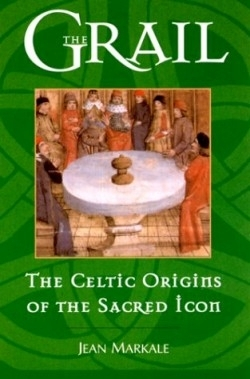The Grail
The Celtic Origins of the Sacred Icon
Every so often a book comes along that so illuminates a particular idea or subject as to make it crystalline. This is one. Markale cuts to the heart of what is known, believed, suspected, misconceived and otherwise attached to the concept of the Grail, dispelling that which is superfluous like so much chaff, and exposing the mature grains of wheat, or in this case grains of reasonable, educated and painstakingly arrived at knowledge, perhaps even truth, if that is possible given the highly subjective and emotional nature of this subject.
Much of what is known about Grail lore becomes much clearer in this delineation of the principal Grail figures of Percival, the Fisher King and Joseph of Arimathea as well as others that inhabit Grail literature. The customary nod to Chetien De Troyes as well as Robert de Boron are also given, yet the central idea is to show the parallels in structure and thought that permeate these tales. Markale strips away the “Christian varnish” to reveal the “pagan substratum” and the Celtic spirituality and mysticism at the core of the Grail lore.
The Grail traces a skeleton structure that is truly amazing in its simplicity and breadth. Through Celtic, Welsh, German, French (Norman) and of course British roots different characters arise such as Percival, Peredur and Parzival. Although these archetypal characters change, their resemblance to one another is unmistakable. Similarly, the Grail can be traced from a pagan story of blood vengeance, symbol of sexual union, to that of the attainment of moral perfection. The author even makes a symbolic connection between the Grail and the salmon that is astounding.
In the final chapter of this thought provoking work, Markale pulls together the many threads presented in The Grail, and takes a stab at deriving a meaning, yet he concedes that “there can never be a single solution” to the Grail quest itself. Markale also says this about the Grail, “The original Grail, in passing from one author to another, has gone from a simple container holding an unspecified content to an object of the highest virtue, the crystal that converges all the rays that are the desires of humanity.”
It is not surprising to find that Markale has spent much of his life researching Celtic civilizations and has authored over forty books on pre-Christian societies, including the Druids and the Celts. Although The Grail may not provide a simple solution for the Grail or the quest that embodies it, it does provide some well-wrought ideas and analyses that place this book on the top shelf of today’s Grail literature.
Reviewed by
Jim Filkins
Disclosure: This article is not an endorsement, but a review. The publisher of this book provided free copies of the book to have their book reviewed by a professional reviewer. No fee was paid by the publisher for this review. Foreword Reviews only recommends books that we love. Foreword Magazine, Inc. is disclosing this in accordance with the Federal Trade Commission’s 16 CFR, Part 255.

